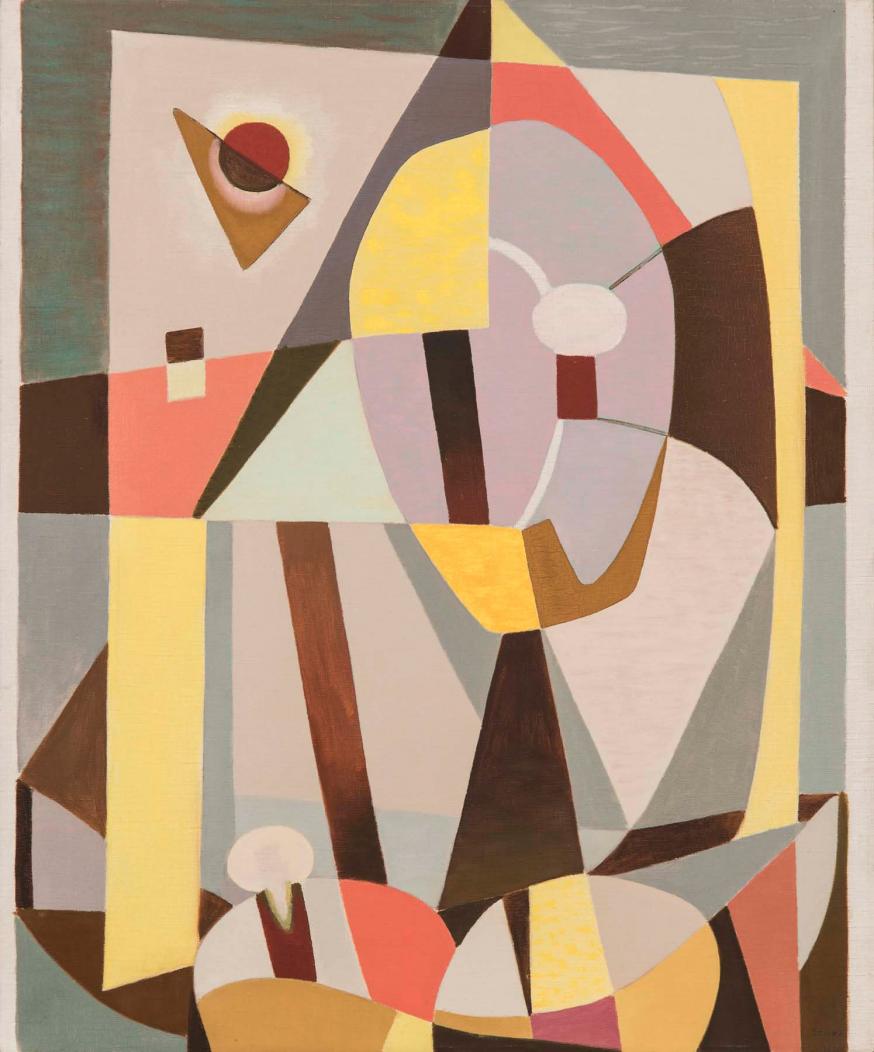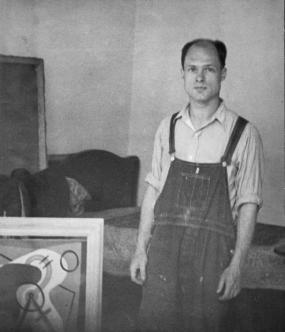Louis Stone
1902–1984


Louis Stone in his studio, c.1938; Photographer unknown, Courtesy of the Louis K. Stone Art Trust
All artworks displayed above are currently available. To inquire about additional works available by this artist, please contact the gallery.
Biography
I want my colors to come alive.
Louis Stone is known for his bold, avant-garde abstract paintings that use vibrant colors in tonal and spatial harmony. During his career, Stone’s work evolved from landscapes and still-lifes to experimental, non-objective works that synthesize a range of styles into uniquely lyrical compositions.
Louis King Stone was born in Findlay, Ohio in 1902. When he was a child, his family moved to Mount Vernon, New York and then Newark, New Jersey. In the 1920s, Stone studied at the Art Academy of Cincinnati, the Pennsylvania Academy of Fine Arts, and the Art Students League in New York City with Boardman Robinson and Thomas Hart Benton before rejoining his family in Lansing, Michigan, where he went to work for a company designing cemetery monuments. In 1927, Stone moved to Providence, Rhode Island and continued to design monuments while also pursuing art. He spent the summer of that year in Gloucester, Massachusetts, where he studied painting with T.K. Breckenridge and met artist Carolyn Hoag, whom he married in the fall. Shortly after the wedding, Stone and Hoag left for Europe.
From 1927 to 1933, Stone and Hoag lived and painted in Europe, spending most of their time in France. In 1928, Stone studied at the Académie Colorossi in Paris, where he would socialize in the afternoon in Montparnasse with artists, poets and writers including Marsden Hartley. Later that year, on a trip to Aix-en-Provence Stone visited Cézanne’s studio and decided to rent the property. For a year and a half, Stone and Hoag lived in Cézanne’s former home, along with friend and fellow artist Charles Evans. In 1929, they moved on to Munich, where Stone attended the Hofmann School of Fine Arts, before relocating to the village of Mirmande, an artist’s colony on one of the foothills of the French Alps. In Mirmande, Stone studied with André Lhote at the artist’s summer school. Like Hofmann, Lhote became an important influence on Stone’s later, non-objective art. In 1933, Stone returned to the United States, living briefly in Woodstock, New York before traveling to Florida where he and painter James S. Morris co-founded the Stone-Morris School of Fine Arts in Jacksonville. However, students had difficulty paying tuition, and the school was forced to close.
In 1935, Stone moved to Lambertville, New Jersey, a town close to New Hope, Pennsylvania, which was home to an active artistic community. To support his family, Stone worked for the easel division of the WPA, painting from his home and creating murals for public buildings throughout the United States. Reunited with Evans, Stone became a leading member of the recently formed Independents, a New-Hope-based modernist artist’s collective founded by Charles F. Ramsey. Like other associations of American artists during this period, the Independents struggled to gain recognition in a culture that was not particularly receptive to abstract art. In 1937 Stone exhibited in the First Annual Member Exhibition of the American Artists’ Congress held in Rockefeller Center, and in 1938, Stone became a co-founder of the Cooperative Painting Project. An independent group inspired by the performances of improvisational jazz musicians, its objective was to recreate the process of composing jazz and discover whether painting could, like music, be a collaborative process. To that end, the Project held visual “jam sessions,” where Stone, Evans, and Ramsey would work together on a single painting, signing the finished work with the combined moniker “Ramstonev.” Stone frequently collaborated and exchanged ideas with other members of the Independents—including B.J.O. Nordfeldt, John Nevin, Lloyd “Bill” Ney, and Elsie Driggs—but his work from the mid-1930s and 1940s retains a distinctive style that demonstrates a mastery of the modernist lessons he learned in Europe and an innovative use of flat color to suggest three dimensional space. In 1939, his work was exhibited at the Worlds Fair in Flushing Meadows, New York City. His painting was shown at the 1940 New Jersey Art Fair at the Newark Museum, and in 1941, he was included in a group exhibition at Princeton University, Paintings and Sculpture by New Jersey Artists, juried by John Marin, Alfred Barr, and Lee Gatch
Stone once remarked that he wanted “to keep his colors alive,” and consequently, his work contains visually complex color harmonies that demonstrate his willingness to break the stylistic conventions of the School of Paris in favor of a more idiosyncratic palette. Stone exhibited regularly and locally throughout the 1950s and 1960s. In 1976, the Princeton Gallery of Fine Art mounted an exhibition of thirty-five paintings. However, a fire at the gallery destroyed the work, eliminating three-years’ worth of creative labor. Stone continued to paint and travel extensively with his family throughout North America until his death in 1984 at the age of 82 at his home near Lambertville, NJ. The last two decades have witnessed a resurgent interest in Stone’s art, which has been a part of several group exhibitions in New York City and was the subject of two solo shows at the Michael Rosenfeld Gallery (2002 and 2006).
Michael Rosenfeld Gallery LLC was the exclusive representative of the Louis K. Stone Art Trust from 2002 to 2024.
Gallery Exhibitions
Press
Publications

